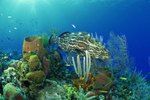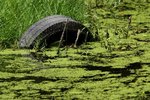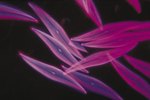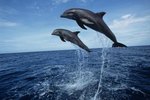
Waves, especially in seas and oceans, are sometimes a force to be reckoned with. To humans, they can go from the soothing sight and sound of water lapping gently at the shore to overwhelming forces of destruction. They can affect marine animals in much the same way, but waves also play a major role in their day-to-day ability to survive and thrive.
Waves
Waves are the result of wind blowing the sea's surface. Although they are visible on the water's surface, they are also felt beneath the surface to varying degrees. A wave that reaches about 6 1/2 high, for example, can be felt beneath the surface as deeply as nearly 20 feet. Waves function to clean organisms near the surface and to help oxygenate the water beneath.
Nutrients
Waves also work in combination with tides and currents to carry nutrients to marine animals along the shorelines. By pushing water onto the shore, waves make it possible for intertidal animals to live in areas of beaches and shorelines that would otherwise be too dry to sustain them. Larger animals, such as fish, whales and other marine mammals, and even some aquatic birds follow the currents -- which also carry plankton, a source of food for many species of marine life -- in search of food and breeding grounds.
Habitat
Waves have a major impact on shorelines and their habitability for various species of marine animals. Waves erode sediment from some shorelines and deposit them on others, creating beaches of sand and gravel that are able to support vastly different species of aquatic life than that which can live along rocky seashores. Another way that waves affect shorelines, and the animals that live along them, is to transform beach slope. This in turn affects the areas that become exposed during low tide, which can either expand or reduce the habitable areas available for intertidal animals.
Life Cycles
Waves play a substantial role in the natural life cycles of intertidal species. Storms and large waves can deposit kelp on beaches, where it provides nourishment for various plants and animals. Marine animals that attach to rocks, such as mussels, sometimes have entire colonies torn away by strong waves, making way for other species to inhabit that area.
References
Photo Credits
-
Digital Vision./Digital Vision/Getty Images
Writer Bio
Jean Marie Bauhaus has been writing about a wide range of topics since 2000. Her articles have appeared on a number of popular websites, and she is also the author of two urban fantasy novels. She has a Bachelor of Science in social science from Rogers State University.




